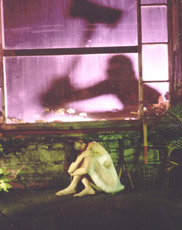
REVIEW
My Bad
through Oct. 13
NFA space
 | Garret Jensen American Baseball Bat #4 |
Sick Boys
Greaser-noir at NFA space
By Laura Thompson
Imagine you are having a dream in which Elvis Presley, Mike Ness, and The Reverend Horton Heat are all after you, chasing you down in a rusty old Ford. You are white-knuckling the steering wheel, cold-sweating through your undershirt, and about to piss your Dickies, but they are suave, tough as nails, and cool as fucking cucumbers.
The driver sits back with his tattooed elbow out the window, his foot probably tapping to something by Carl Perkins or The Dead Boys. All you hear is your engine sputtering, chastising you for those last four Old Grand Dads you downed at Delilah's last Wednesday - the ones that got you a little too friendly with Ness's girl (Bettie Page-who else?). You swerve around a corner - a dead end - and that's when they've got you. They swoop out of the car, stroking their guns, baseball bats, and heavy flashlights, staring you down. The Reverend and Ness come at your from either side, one of them is laughing, and Ness boxes you right in the face. Soon there is blood in your eyes, burning and bright red, staining your shirt. Everything slows down, like something from a movie, and right before you pass out, all you can smell is hair grease and car exhaust, and you remember how sweet Bettie looked as she slowly licked lipstick off her teeth...
Sound like the best nightmare you've never had? Visit Garrett Jensen's My Bad at NFA Space, and you can indulge in some rock n' roll pulp, root for the bad guys, and walk away unscathed but not unchallenged. Jensen's photographs address stereotypes of violence. In one series entitled "American Baseball Bat", Jensen depicts a gang of slick, heavily tattooed greasers out for revenge (or maybe just some dirty fun), while another entitled "Wreck on the Highway" captures the aftermath of a nighttime car accident.
Jensen's images seem like they were culled from the cinema. For example, in strikingly lit scenes, retro-styled characters often gaze off camera seemingly towards unseen adversaries, suggesting that the images are only ambiguous snippets of a continuing narrative. For the most part, violent events such as fistfights are contained within the boundaries of each picture, allowing the viewer to remain safely separate and unimplicated.
But the sharply confrontational "American Baseball Bat #4" is more problematic. The piece captures the end of a fight, the victor having just knocked his victim unconscious with his bare hands. He looks up at the camera with a chilling amount of composure as blood drips down his face. Here the barrier that voyeurism allows is stripped away. The viewer is placed in an uncertain and uncomfortable position: are you a buddy looking on or are you the next victim? This exchange between the aggressor in the image and viewer of the image highlights the often ambiguous role of the viewer of violence. Is the viewer ever a participator? Where is the division between watching violence and condoning it?
The drama of violence, weapons, blood, and seeming lack of repentance in My Bad is powerful and possibly shocking to some viewers. But often times, the work's seriousness is undermined by its staged nature. The men and women knowingly play their characters in a way that borders on self-parody. Indeed, they are types: the tough guy, the jealous lover, the femme fatale.
In "American Baseball Bat #2" a man grabs his girlfriend from the ground by her hair in a scene that recalls the notorious caveman/ woman scenario, but her gaze into the camera subverts the cliche. She seems to be on the verge of rolling her eyes at its triteness, as if to say, "Oh, come on!"
Exaggeration is also apparent elsewhere: the men's pants are pressed a little too well, their white shirts a little too crisp, shoes a little too shiny; and maybe their malevolent posture is even a bit elaborate, or their punches a little lazy. Given, there is a fair amount of blood in the photos, but it is a little too red and watery, drizzled like ink on the ground or on clothing. And although the victims are bloody, they are virtually without wounds.
This palpable artificiality links the work's cinematic character to its sense of satire. Jensen constructs a world of perpetual darkness, crime, and passion that is romantic and nostalgic, and simultaneously mocks that world's very appeal. The clothes, hairstyles, classic tattoos, and automobiles, all evocative of a past era, are attractive. We like the characters because they are bad. They seem impulsive, dangerous, and conflicted
- they belong to that crowd your parents warned you about. But they also look like people you might know or pass on the street, people whose favorite hobby is not likely to be ultra-violence. In this way, Jensen also points to the way that fashion may carry a certain stigma or stereotype and reveals the irrationality of such conclusions. Jensen's work exposes multiple sides of the nature of violence - as primal, as mysterious, and also as potentially misleading.
My Bad runs at NFA Space, 119 N. Peoria St., through October 13.
|

